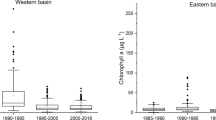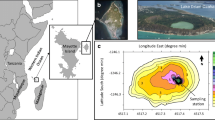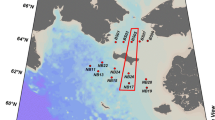Abstract
Winter phytoplankton communities in the shallow alkaline pans of Hungary are frequently dominated by picoeukaryotes, sometimes in particularly high abundance. In winter 2012, the ice-covered alkaline Zab-szék pan was found to be extraordinarily rich in picoeukaryotic green algae (42–82 × 106 cells ml−1) despite the simultaneous presence of multiple stressors (low temperature and light intensity with high pH and salinity). The maximum photosynthetic rate of the picoeukaryote community was 1.4 μg C μg chlorophyll a −1 h−1 at 125 μmol m−2 s−1. The assimilation rates compared with the available light intensity measured on the field show that the community was considerably light-limited. Estimated areal primary production was 180 mg C m−2 d−1. On the basis of the 18S rRNA gene analysis (cloning and DGGE), the community was phylogenetically heterogeneous with several previously undescribed chlorophyte lineages, which indicates the ability of picoeukaryotic communities to maintain high genetic diversity under extreme conditions.




Similar content being viewed by others
References
Bec B, Collos Y, Souchu P, Vaquer A, Lautier J, Fiandrino A, Benau L, Orsoni V, Laugier T (2011) Distribution of picophytoplankton and nanophytoplankton along an anthropogenic eutrophication gradient in French Mediterranean coastal lagoons. Aquat Microb Ecol 63:29–45
Boros E, Nagy T, Pigniczki C, Kotymán L, V-Balogh K, Vörös L (2008) The effect of aquatic birds on the nutrient load and water quality of soda pans in Hungary. Acta Zool Hung 54:207–224
Borsodi AK, Felföldi T, Máthé I, Bognár V, Knáb M, Krett G, Jurecska L, Tóth EM, Márialigeti K (2013) Phylogenetic diversity of bacterial and archaeal communities inhabiting the saline Lake Red located in Sovata, Romania. Extremophiles 17:87–98
Callieri C, Stockner G (2002) Freshwater autotrophic picoplankton: a review. J Limnol 61:1–14
Callieri C (2008) Picophytoplankton in freshwater ecosystems: the importance of small-sized phototrophs. Freshwat Rev 1:1–28
Cuthbert ID, del Giorgio P (1992) Toward a standard method of measuring color in freshwater. Limnol Oceanogr 37:1319–1326
Eilers PHC, Peeters JCH (1988) A model for the relationship between light intensity and the rate of photosynthesis in phytoplankton. Ecol Model 42:199–215
Elliott RJ, Porter AG (1971) A rapid cadmium reduction method for the determination of nitrate in bacon and curing brines. Analyst 96:522–527
Fanjing K, Qinxian J, Jia E, Mianping Z (2009) Characterization of a eukaryotic picoplankton alga, strain DGN-Z1, isolated from a soda lake in Inner Mongolia, China. Nat Resour Env Iss 15:185–189
Felföldi T, Somogyi B, Márialigeti K, Vörös L (2009) Characterization of photoautotrophic picoplankton assemblages in turbid, alkaline lakes of the Carpathian Basin (Central Europe). J Limnol 68:385–395
Felip M, Catalan J (2000) The relationship between phytoplankton biovolume and chlorophyll in a deep oligotrophic lake: decoupling in their spatial and temporal maxima. J Plankton Res 22:91–105
Gales MEJR, Julian EC, Kroner RC (1966) Method for quantitative determination of total phosphorus in water. J Amer Water Works Assoc 58:1363–1368
García CM, García-Ruiz R, Rendón M, Niell FX, Lucena J (1997) Hydrological cycle and interannual variability of the aquatic community in a temporary saline lake (Fuente de Piedra, Southern Spain). Hydrobiologia 345:131–141
Gaulke AK, Wetz MS, Paerl HW (2010) Picophytoplankton: a major contributor to planktonic biomass and primary production in a eutrophic, river-dominated estuary. Estuar Coast Shelf S 90:45–54
Han M-S, Furuya K (2000) Size and species-specific primary production and community structure of phytoplankton in Tokyo Bay. J Plankton Res 22:1221–1235
Harper DM, Childress RB, Harper MM, Boar RR, Hickley PH, Mills SC, Otieno N, Drane T, Vareschi E, Nasirwa O, Mwatha WE, Darlington JPEC, Escuté-Gasulla X (2003) Aquatic biodiversity and saline lakes: Lake Bogoria National Reserve, Kenya. Hydrobiologia 500:259–276
Henley WJ, Hironaka JL, Guillou L, Buchheim MA, Buchheim JA, Fawley MW, Fawley KP (2004) Phylogenetic analysis of the ‘Nannochloris-like’ algae and diagnoses of Picochlorum oklahomensis gen. et sp. nov (Trebouxiophyceae, Chlorophyta). Phycologia 43:641–652
Herodek S, Tamás G (1976) A fitoplankton tömege, termelése és a Balaton eutrofizálódása. Hidrológiai Közlöny 56(5):219–228
Herodek S, Vörös L, Tóth F (1982) The mass and production of phytoplankton and the eutrophication of Lake Balaton. Hidrológiai Közlöny 62(5):220–229 (in Hungarian with English summary)
Jones HLJ, Leadbeater BSC, Green JC (1994) An ultrastructural study of Marsupiomonas pelliculata gen. et sp. nov., a new member of the Pedinophyceae. Eur J Phycol 29:171–181
Keresztes ZG, Felföldi T, Somogyi B, Székely G, Dragoş N, Márialigeti K, Bartha C, Vörös L (2012) First record of picophytoplankton diversity in Central European hypersaline lakes. Extremophiles 16:759–769
Kirk JTO (1996) Light and photosynthesis in aquatic ecosystems. Cambridge University Press, Cambridge
Krienitz L, Hegewald EH, Hepperle D, Huss VAR, Rohr T, Wolf M (2004) Phylogenetic relationship of Chlorella and Parachlorella gen. nov. (Chlorophyta, Trebouxiophyceae). Phycologia 43:529–542
Krienitz L, Bock C, Kotut K, Luo W (2012) Picocystis salinarum (Chlorophyta) in saline lakes and hot springs of East Africa. Phycologia 51:22–32
Lewin RA, Krienitz L, Goericke R, Takeda H, Hepperle D (2000) Picocystis salinarum gen. et sp. nov. (Chlorophyta)—a new picoplanktonic green alga. Phycologia 39:560–565
Luo W, Kotut K, Krienitz L (2013) Hidden diversity of eukaryotic plankton in the soda lake Nakuru, Kenya, during a phase of low salinity revealed by a SSU rRNA gene clone library. Hydrobiologia 702:95–103
MacIsaac EA, Stockner JG (1993) Enumeration of phototrophic picoplankton by autofluorescence microscopy. In: Kemp PF, Sherr BF, Sherr EB, Cole JJ (eds) Handbook of methods in aquatic microbial ecology. Lewis Publishers, Boca Raton, pp 187–197
Mackereth FJH, Heron J, Talling JF (1989) Water analysis: some revised methods for limnologists. Freshwater Biological Association Scientific Publications, Ambleside
Mózes A, Présing M, Vörös L (2006) Seasonal dynamics of picocyanobacteria and picoeukaryotes in a large shallow lake (Lake Balaton, Hungary). Int Rev Hydrobiol 91:38–50
Murphy J, Riley JP (1962) A modified single solution method for the determination of phosphate in natural waters. Anal Chim Acta 27:31–36
Newell BS, Morgan B, Candy J (1967) The determination of urea in seawater. J Mar Res 25:201–202
Palatinszky M, Nikolausz M, Sváb D, Márialigeti K (2011) Preferential ligation during TA-cloning of multitemplate PCR products: a factor causing bias in microbial community structure analysis. J Microbiol Meth 85:131–136
Pruesse E, Peplies J, Glöckner FO (2012) SINA: accurate high throughput multiple sequence alignment of ribosomal RNA genes. Bioinformatics 28:1823–1829
Schagerl M, Oduor SO (2008) Phytoplankton community relationship to environmental variables in three Kenyan Rift Valley saline-alkaline lakes. Mar Freshwater Res 47:189–197
Schloss PD, Westcott SL, Ryabin T, Hall JR, Hartmann M, Hollister EB, Lesniewski RA, Oakley BB, Parks DH, Robinson CJ, Sahl JW, Stres B, Thallinger GG, Van Horn DJ, Weber CF (2009) Introducing mothur: open-source, platform-independent, community-supported software for describing and comparing microbial communities. Appl Environ Microbiol 75:7537–7541
Somogyi B, Felföldi T, Vanyovszki J, Ágyi Á, Márialigeti K, Vörös L (2009) Winter bloom of picoeukaryotes in Hungarian shallow turbid soda pans and the role of light and temperature. Aquat Ecol 43:735–744
Somogyi B, Felföldi T, Solymosi K, Makk J, Homonnay ZG, Horváth G, Turcsi E, Böddi B, Márialigeti K, Vörös L (2011) Chloroparva pannonica gen. et sp. nov. (Trebouxiophyceae, Chlorophyta): a new picoplanktonic green alga from a turbid, shallow soda pan. Phycologia 50:1–10
Somogyi B, Felföldi T, Solymosi K, Flieger K, Márialigeti K, Böddi B, Vörös L (2013) One step closer to eliminating nomenclatural problems of minute coccoid green algae: Pseudochloris wilhelmii gen. et sp. nov. (Trebouxiophyceae, Chlorophyta) Eur J Phycol 48:427–436
Steemann Nielsen E (1952) The use of radioactive carbon (C-14) for measuring organic production in the sea. J Conseil Perm Int Pour L’Explor De La Mer 18:117–140
Stockner JG, Antia NJ (1986) Algal picoplankton from marine and freshwater: a multidisciplinary perspective. Can J Fish Aquat Sci 43:2472–2503
Tamura K, Peterson D, Peterson N, Stecher G, Nei M, Kumar S (2011) MEGA5: molecular evolutionary genetics analysis using maximum likelihood, evolutionary distance, and maximum parsimony methods. Mol Biol Evol 28:2731–2739
Tulonen T, Kankaala P, Ojala A, Arvola L (1994) Factors controlling production of phytoplankton and bacteria under ice in a humic, boreal lake. J Plankton Res 16:1411–1432
V.-Balogh K, Németh B, Vörös L (2009) Specific attenuation coefficients of optically active substances and their contribution to the underwater ultraviolet and visible light climate in shallow lakes and ponds. Hydrobiologia 632:91–105
Vaulot D, Eikrem W, Viprey M, Moreau H (2008) The diversity of small eukaryotic phytoplankton (≤3 μm) in marine ecosystems. FEMS Microbiol Rev 32:795–820
Vörös L, Gulyás P, Németh J (1991) Occurrence, dynamics and production of picoplankton in Hungarian shallow lakes. Int Rev Hydrobiol 76:617–629
Vörös L, Padisák J (1991) Phytoplankton biomass and chlorophyll-a in some shallow lakes in central Europe. Hydrobiologia 215:111–119
Vörös L, V-Balogh K, Boros E (2005) Picoplankton predominance in soda lakes. Hidrológiai Közlöny 85(6):166–168 (in Hungarian with English summary)
Vörös L, Boros E, Schmidt A, V.-Balogh K, Németh B, Somogyi B, Mózes A (2006) Physical and chemical environment of phytoplankton in soda pans having white coloured water. Hidrológiai Közlöny 86(6):139–141 (in Hungarian with English summary)
Vörös L, Mózes A, Somogyi B (2009) A five-year study of autotrophic winter pikoplankton in Lake Balaton, Hungary. Aquat Ecol 43:727–734
Winder M (2009) Photosynthetic picoplankton dynamics in Lake Tahoe: temporal and spatial niche partitioning among prokaryotic and eukaryotic cells. J Plankton Res 31:1307–1320
Wellburn AR (1994) The spectral determination of chlorophylls a and b, as well as total carotenoids, using various solvents with spectrophotometers of different resolution. J Plant Physiol 144:307–313
Wetzel RG, Likens GE (2000) Limnological analyses. Springer, New York
Wu QL, Chatzinotas A, Wang J, Boenigk J (2009) Genetic diversity of eukaryotic plankton assemblages in Eastern Tibetan lakes differing by their salinity and Altitude. Microb Ecol 58:569–581
Acknowledgments
The authors are gratefully indebted to Balázs Németh, Zsolt Gyula Keresztes, Tamás Sápi and Éva Koltai for technical assistance. This work was financially supported by the NKTH-OTKA CNK 80140 and the EnvEurope Life Environment LIFE08ENV/IT/000339 projects. B.S. and T.F. were supported by the Bolyai János Research Grant (Hungarian Academy of Sciences).
Author information
Authors and Affiliations
Corresponding author
Additional information
Communicated by M. da Costa.
Rights and permissions
About this article
Cite this article
Pálffy, K., Felföldi, T., Mentes, A. et al. Unique picoeukaryotic algal community under multiple environmental stress conditions in a shallow, alkaline pan. Extremophiles 18, 111–119 (2014). https://doi.org/10.1007/s00792-013-0602-0
Received:
Accepted:
Published:
Issue Date:
DOI: https://doi.org/10.1007/s00792-013-0602-0




